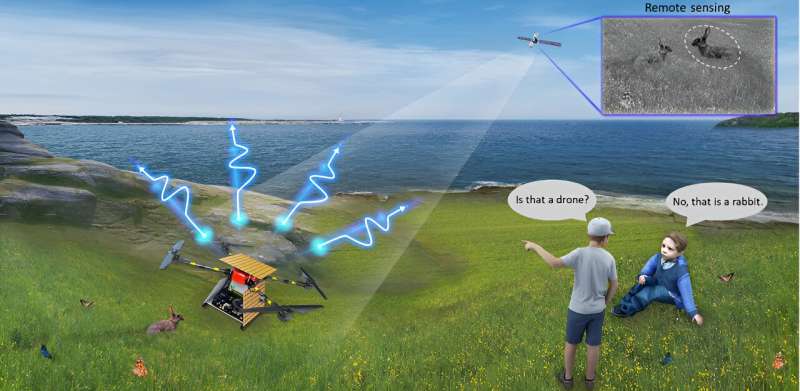This article has been reviewed according to Science X's editorial process and policies. Editors have highlighted the following attributes while ensuring the content's credibility:
fact-checked
trusted source
proofread
Designing a drone that uses adaptive invisibility: Towards autonomous sea-land-air cloaks

The idea of objects seamlessly disappearing, not just in controlled laboratory environments but also in real-world scenarios, has long captured the popular imagination. This concept epitomizes the trajectory of human civilization, from primitive camouflage techniques to the sophisticated metamaterial-based cloaks of today.
Recently, this goal was further highlighted in Science, as one of the "125 questions: exploration and discovery." Researchers from Zhejiang University have made strides in this direction by demonstrating an intelligent aero amphibious invisibility cloak. This cloak can maintain invisibility amidst dynamic environments, neutralizing external stimuli.
Despite decades of research and the emergence of numerous invisibility cloak prototypes, achieving an aero amphibious cloak capable of manipulating electromagnetic scattering in real-time against ever-changing landscapes remains a formidable challenge. The hurdles are multifaceted, ranging from the need for complex-amplitude tunable metasurfaces to the absence of intelligent algorithms capable of addressing inherent issues such as non-uniqueness and incomplete inputs.
Addressing these challenges head-on, a team at Zhejiang University has unveiled a self-driving, cloaked unmanned drone. As reported in Advanced Photonics, this drone seamlessly integrates perception, decision-making, and execution functionalities.
The key lies in spatiotemporal modulation applied to reconfigurable metasurfaces, enabling the customization of scattering fields across space and frequency domains. To power this innovation, they propose a generation–elimination neural network, also known as stochastic-evolution learning.
This network globally guides the spatiotemporal metasurfaces, automatically seeking optimal solutions with maximum probabilistic inference, thus resolving the one-to-many issues inherent in the inverse design. In a groundbreaking experiment, the team implemented this concept on an unmanned drone platform, demonstrating adaptive invisibility across three canonical landscapes: sea, land, and air.
This fusion of spatiotemporal metasurfaces, deep learning, and advanced control systems extends the realm of invisibility cloaks to aerial platforms. The integrated neural network serves as a sophisticated commander, unraveling the complex interaction between waves and metasurfaces.
This breakthrough heralds a new paradigm in inverse design, offering solutions to many-to-many correspondences. Beyond immediate applications, this work serves as a catalyst for inspiring future research in materials discovery and the development of adaptive meta devices. Moving forward, further advancements can address current limitations, such as bandwidth constraints and challenges related to full polarization.
More information: Chao Qian et al, Autonomous aeroamphibious invisibility cloak with stochastic-evolution learning, Advanced Photonics (2024). DOI: 10.1117/1.AP.6.1.016001
Provided by SPIE




















